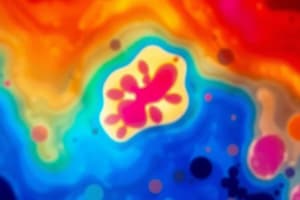Podcast
Questions and Answers
What is the purpose of fecal examination in veterinary helminthology?
What is the purpose of fecal examination in veterinary helminthology?
To provide evidence of or accurate identification of most of the parasites which inhabit the alimentary tract.
Which of the following might appear in feces as pseudoparasites? (Select all that apply)
Which of the following might appear in feces as pseudoparasites? (Select all that apply)
- Plant hairs (correct)
- Parasite eggs
- Pollen grains (correct)
- Mold spores (correct)
Fresh feces should be used for fecal sample collection to avoid __________.
Fresh feces should be used for fecal sample collection to avoid __________.
dehydration
Old fecal samples can be useful for accurate microscopic examination.
Old fecal samples can be useful for accurate microscopic examination.
Which technique is NOT a method for qualitative microscopic examination of feces?
Which technique is NOT a method for qualitative microscopic examination of feces?
What characteristics are described for the family Fasciolidae?
What characteristics are described for the family Fasciolidae?
Fasciolidae are considered hermaphrodites.
Fasciolidae are considered hermaphrodites.
Which of the following are common helminth eggs found in pigs? (Select all that apply)
Which of the following are common helminth eggs found in pigs? (Select all that apply)
Flashcards are hidden until you start studying
Study Notes
Fecal Examination in the Diagnosis of Parasitism
- Fecal examines provide evidence of or identify parasites found in the alimentary tract
- Parasites of the respiratory tract can be diagnosed through fecal examination
- Fecal exams can reveal the status of digestion
Pseudoparasites
- Objects in the feces that mimic parasites are known as pseudoparasites
- Pollen grains, plant hairs, grain mites, mold spores, and other plant or animal debris can be found in feces
- Spurious parasites are also encountered, which can include parasite eggs or cysts that are found in the feces of scavenger or predator hosts due to coprophagy
Fecal Sample Collection
- Always use fresh feces when collecting samples
- If the sample is kept for an extended period of time it may become dehydrated making suspension difficult
- Old samples may disintegrate, hatch or develop which can disrupt diagnosis
- If the sample is transported for more than a few hours it must be preserved using 10% formalin and refrigerated
Microscopic Examination of Feces
- There are three types of microscopic examination: simple fecal smear method, qualitative microscopic concentration methods of fecal examination, and quantitative methods of fecal examination
Simple Fecal Smear Method
- This method is a simple direct smear method that allows visualization of parasites
Qualitative Microscopic Concentration Methods of Fecal Examination
- Sugar Flotation Technique
- Willi’s Brine Flotation Technique
- Modified Fluke Egg Technique
Quantitative Methods of Fecal Examination
- Stoll Ova-Counting Technique
- McMaster Egg-Counting Technique
- Beaver’s Direct Egg-Count Technique
- Larval Culture of Sheep and Goat
- Baermann Apparatus
- Filter Paper Strips
Common Helminth Eggs in Ruminants
- Eggs of various helminths are found in the feces of ruminants
Common Helminth Eggs in Pigs
- Eggs of various helminths are found in the feces of pigs
Common Helminth Eggs in Poultry
- Eggs of various helminths are found in the feces of poultry
Common Helminth Eggs in Horses
- Eggs of various helminths are found in the feces of horses
Common Helminth Eggs in Dogs & Cats
- Eggs of various helminths are found in the feces of dogs and cats
Common Helminth Eggs in Rabbits
- Eggs of various helminths are found in the feces of rabbits
Common Helminth Eggs in Rodents
- Eggs of various helminths are found in the feces of rodents
Common Helminth Eggs in Reptiles
- Eggs of various helminths are found in the feces of reptiles
The Family Fasciolidae
- The body is large and leaf-like, with suckers close together at the anterior end
- Parasites of the liver and bile ducts of herbivorous mammals and man
- They are hermaphrodites
- Ovary and testes are dendritic
- Eggs have a large operculum
Studying That Suits You
Use AI to generate personalized quizzes and flashcards to suit your learning preferences.




